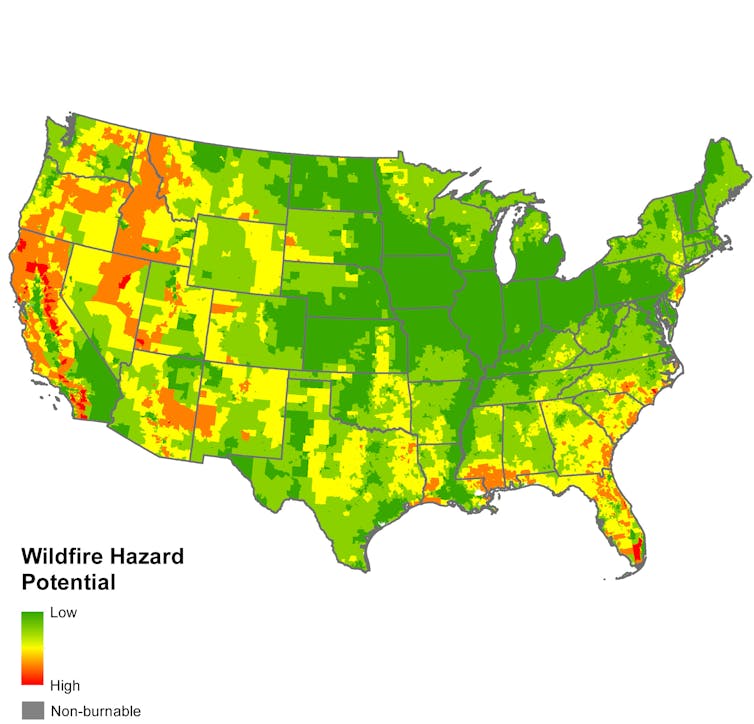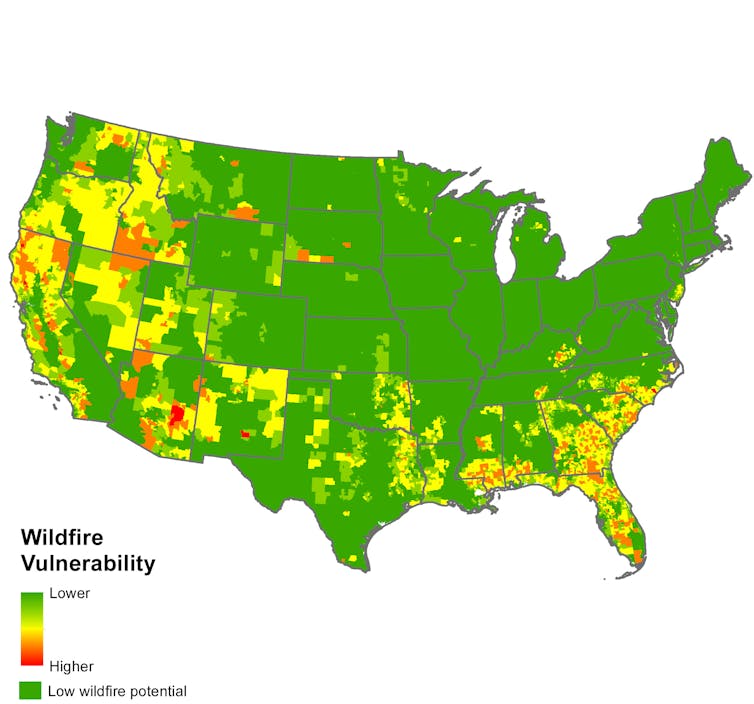Racial and ethnic minorities are more vulnerable to wildfires
- Written by Phil Levin, Professor of Practice in Environmental and Forest Sciences, University of Washington
Over the last decade, the U.S. has seen an average of 70,512 wildland fires every year[1], annually burning about 6.8 million acres. With climate change, scientists expect fires to become more frequent and more severe[2].
However, some people are more affected by these events than others. Our work[3], published on Nov. 2, shows that racial and ethnic minorities are significantly more vulnerable to the effects of these natural disasters. The results provide a new perspective on where resources to mitigate wildfire threats are best allocated.
We were inspired to study this question by Hurricane Katrina, the catastrophe that ripped through New Orleans in 2005. Black neighborhoods were located in the low-lying, less protected areas of the city, and many lacked the resources to evacuate safely[4]. After the storm cleared, black-owned homes were three times more likely than their white counterparts to be in the flooded parts of the city, and to this day the city’s black population has not rebounded to pre-Katrina population levels[5].
Other research[6] on floods and hurricanes has shown similarly disproportionate effects on minorities. We wondered if a similar phenomenon existed for wildfires.
 This map shows wildfire potential, as determined by the U.S. Forest Service, by census tract. White lines on the map correspond to U.S. census tracts. The potential for an area to burn is calculated by considering factors such as burnable fuels on the landscape, vegetation, weather and historical fire activity.
Ian Davies, CC BY[7]
This map shows wildfire potential, as determined by the U.S. Forest Service, by census tract. White lines on the map correspond to U.S. census tracts. The potential for an area to burn is calculated by considering factors such as burnable fuels on the landscape, vegetation, weather and historical fire activity.
Ian Davies, CC BY[7]
Using data from the U.S. Census, we created an index that characterizes a community’s ability to adapt to wildfires. For example, signs that a community is less able to adapt to a wildfire include a prevalence of older or younger individuals; high rates of poverty; and a high proportion of people who are not fluent English speakers. We then calculated this metric for more than 70,000 census tracts across the U.S. and combined the results with the area’s potential for wildfires, as modeled by the U.S. Forest Service.
Our analysis revealed that wildfire vulnerability is spread unequally across race and ethnicity. Although affluent white Americans are more likely to live in fire-prone areas, non-white communities in fire-prone areas appear less able to adapt to a wildfire event. Communities that are majority black, Hispanic or Native American are over 50 percent more vulnerable to wildfire compared to other communities. Native Americans in particular are six times more likely than other groups to live in the most vulnerable communities.
 This map shows wildfire vulnerability by census tract. Wildfire vulnerability takes into account both landscape wildfire risk and socioeconomic factors in determining how likely an area is to adapt and recover from a wildfire.
Ian Davies, CC BY[8]
This map shows wildfire vulnerability by census tract. Wildfire vulnerability takes into account both landscape wildfire risk and socioeconomic factors in determining how likely an area is to adapt and recover from a wildfire.
Ian Davies, CC BY[8]
Overall, some 29 million Americans live with significant potential for wildfires. Land managers often prioritize areas with extreme wildfire potential for active management, regardless of the capacity of individuals to absorb and recover from a disaster. By including a community’s capacity to respond to wildfire, we highlight those places that may be less resilient to a wildfire’s catastrophic impacts.
How can land managers and policymakers use this information to more effectively combat the impacts of wildfire? Current efforts by agencies and NGOs have largely focused on reducing the risk of fire[9]. But no matter how effective such management is, there will still be wildfires across the U.S. – they are a natural, indeed necessary, part of many ecosystems.
However, natural resource managers can further reduce vulnerability of people to fire by increasing the adaptive capacity of affected communities. There are already some services in place; for example, some state[10] and county[11] agencies have cost-sharing programs to help homeowners reduce fuels on their properties, while others offer educational[12] programs to help communities adapt to wildfires. However, there is evidence[13] that socially vulnerable populations are less likely to participate in these types of government programs.
Cultural differences may also affect preferences for fire management. For example, black Americans have shown more reluctance toward some fire management practices, such as prescribed burning,[14] than their white counterparts.
All loss of life is tragic, and the devastation caused by property loss is terrible for all victims, no matter their race or ethnicity. Like some other scholars, we feel that it’s time to stop thinking of “natural” disasters as natural[15], and start thinking of them as the consequences of social, economic and political factors that make communities more vulnerable to ruin. Facing the rising risk of fires due to climate change, communities must make sure that emergency planning and mitigation strategies are inclusive of vulnerable minorities, so that no one is left behind.
References
- ^ 70,512 wildland fires every year (www.nifc.gov)
- ^ more frequent and more severe (dx.doi.org)
- ^ Our work (doi.org)
- ^ lacked the resources to evacuate safely (doi.org)
- ^ pre-Katrina population levels (www.nytimes.com)
- ^ Other research (reliefweb.int)
- ^ CC BY (creativecommons.org)
- ^ CC BY (creativecommons.org)
- ^ risk of fire (www.washingtonnature.org)
- ^ state (www.dnr.wa.gov)
- ^ county (bewildfireready.org)
- ^ educational (fireadapted.org)
- ^ evidence (doi.org)
- ^ some fire management practices, such as prescribed burning, (srs.fs.fed.us)
- ^ stop thinking of “natural” disasters as natural (doi.org)
Authors: Phil Levin, Professor of Practice in Environmental and Forest Sciences, University of Washington
Read more http://theconversation.com/racial-and-ethnic-minorities-are-more-vulnerable-to-wildfires-106290

